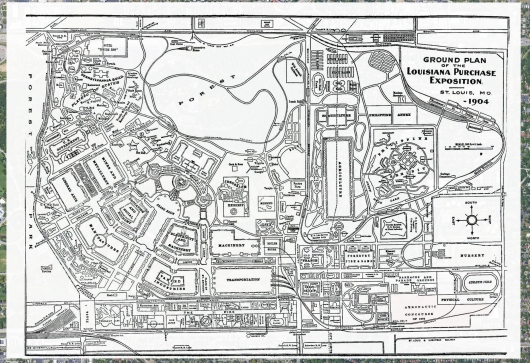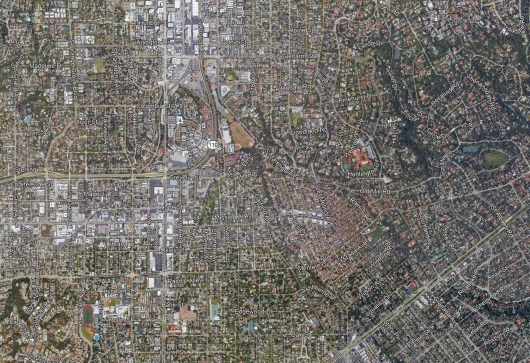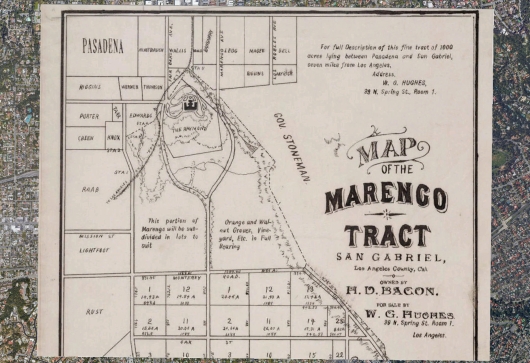The Baldwin "California Arrow" was a most fascinating study. Two superb locations were identified where the locations of flights of the California Arrow were positively identified. These were the St. Louis World's Fair of 1904, and the Raymond Hotel, in Pasadena, California.
The "California Arrow":
Photo credits: Rosebud's WWI and Early Aviation Image Archive
http://www.earlyaeroplanes.com/archive/airships01/1904.Baldwin.CalArrow.St.Louis.Knabenshue.jpg
[Note: In this very fine photo, which is of a postcard of the California Arrow at the St. Louis World's Fair in 1904, the originator of the postcard has written "Capt Thomas Baldwin June 28 - 07", and dated the card "6/28 -07 in the upper right corner. The card's sender, Tom Packard, is referring to a flight of the "California Arrow No. 4" which he witnessed on this is date in 1907. Nevertheless, the photo is of the original California Arrow.]
Construction
Not much is written about the Baldwin airships in terms of construction, but what one can see from photos, it was a completely "basic" design, a suspended triangular frame catwalk as a "control car" under a set of square-mesh nets of strong cord which, upon inflation of the the gas bag, contain and held the gas bag captive.
Baldwin was looking for something to "re-energize" the public which he had perceived were losing interest, especially as paying customers, with static balloons. Baldwin had read about the success of Alberto Santos-Dumont and his airship No.1, making the news in 1898. So interested he was, that Baldwin traveled to France to study the state-of-the-art in dirigibles. Upon returning to the US, he spent the next 4 years just trying to find a suitable engine, light enough for his design! He finally obtained an engine built by none other than Glenn Curtiss, then a builder of motorcycles in Hammondsport, New York. Only Glenn Curtiss was, at the time, designing and building 2-cylinder engines light enough for airship use!
The California Arrow was completed in July 1904, in San Francisco. The wooden frame held the Curtiss engine which produced 5-7 hp, the output shaft of which was connected to a rudimentary propeller. The pilot simply stood on the frame and used his own weight to "balance" the craft, as very little in the way ballast could be carried.
The Gas-bag envelope was 54 feet long, the control "car" was 48 feet long, made up of square cedar struts (painted a silver color resulting in an "aluminum" appearance) and piano wire cross bracing making the entire frame very rigid. The gas bag is cigar-shaped, made of Japanese silk "painted" with linseed oil to seal the silk and make it both impervious to gas, and relatively waterproof, had a capacity of 8,000 cubic feet of hydrogen. The envelope of the gas bag was "contained" by a thin diameter, rope netting attached to the control car along its full length.
The Curtiss engine weighed only 60 pound, and was located in the control car frame just forward of the center of gravity, and so geared as to generate 150 revolutions per minute at the propeller shaft. The total weight of the airship was only 520 pounds, and had an estimated life capacity of about 500 pounds over the airship's weight.
It should be said here, that Baldwin's airship design which became the California Arrow,influenced airship design in the US from that point forward, to at least 1910 when airships began to grow in volume so as to carry passengers.
Operations
"Operations" actually consisted of Baldwin getting himself invited to demonstrations, and hauling his airships around the country to do just that! The California Arrow was wonderfully designed, if not marginally designed, because after only a few test flights in Idora Park, Oakland, California in early August of 1904, Baldwin arranged for a demonstration of his airship at the St. Louis World Fair, in an apparent attempt at a $100,000 cash prize for the first to control an airship over a predefined course.
I say "marginally designed" because Baldwin arrived in St. Louis while Baldwin himself, was too heavy to fly the thing! He had to hire a lighter-weight pilot! That pilot turned out to be Augustus Roy Knabenshue! (Knabenshue went on to be quite the entrepreneur in aviation. See Knabenshue on this site.
The altitude of Baldwin's early airships was not regulated by means of a gas valve attached to the balloon. They had no valve! When the gas-bag is filled with hydrogen the neck of the gas inlet was simply tied-off with a piece of rubber. Elevation was provided by the volume of gas in the gas-bag, and the payload weight. Then after rising to a certain height the gas, which expanded due to the decrease in atmospheric pressure, would exert pressure against the constraint of the rubber tie around neck of the gas inlet. Overcoming the tie-off, some gas volume would be release allowing the machine to settle and stabilize at altitude! Of course, as the sun further heated the gas, the whole process would repeat, limiting the vehicle's altitude and endurance.
Ascent and descent was affected by a weight which could be shifted from bow to stern, or vice-versa and permits the nose of the airship to be raised or lowered. The pilot could also scramble forward or aft on the gondola's framework, thus subtracting of adding to the tilt of the nose. Using the thrust of the propeller alone, the airship was then "pulled" in the desired direction, though the pilot also had the luxury of reversing the rotation of the propeller if need. Directional turns were provided by a 5 by 3.5 foot rudder, which could be activated by the pilot from anywhere along the frame. Only about 20 pounds of ballast was carried for emergencies.
Demise
On April 18, 1906, a massive earthquake struck San Francisco. This was the great quake of 1906, and Thomas Baldwin's manufacturing facility on Market Street was destroyed. He lost five airships including the California Arrow.
Ignominious End
Baldwin had one airship remaining, which he had relocated to Hammondsport, New York, before the earthquake. Baldwin then moved to Hammondsport and, in collaboration with Glenn Curtiss was able to use Curtiss's facilities for his continued airship work. Baldwin's demonstration of the abilities of the "California Arrow near the end of 1904, very much impressed the US Army, and in 1907 announced a request for bids for an airship. Baldwin was awarded a contract to provide the Army with an airship. In 1908 he delivered a 95-foot long airship which could be crewed by two, and the Army accepted it, and it entered inventory as "Signal Corps No. 1". After working with the Army to train Army Officers to fly the airship, Baldwin built at least another couple of airships in 1909. He then moved into heavier-than-air work, but joined the Army in WW I where he served the Signal Corps as Chief of Balloon Inspection and Production. After the war, worked for the Goodyear Tire and Rubber Company in Akron, Ohio, in design and manufacturing of Goodyear airships. Thomas S. Baldwin died on May 17, 1923, in Buffalo, New York, at the age of 69.










